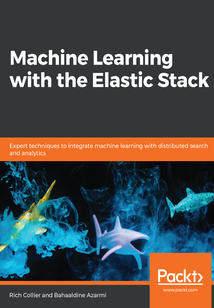舉報 

會員
Machine Learning with the Elastic Stack
MachineLearningwiththeElasticStackisacomprehensiveoverviewoftheembeddedcommercialfeaturesofanomalydetectionandforecasting.ThebookstartswithinstallingandsettingupElasticStack.Youwillperformtimeseriesanalysisonvariedkindsofdata,suchaslogfiles,networkflows,applicationmetrics,andfinancialdata.Asyouprogressthroughthechapters,youwilldeploymachinelearningwithintheElasticStackforlogging,security,andmetrics.Intheconcludingchapters,youwillseehowmachinelearningjobscanbeautomaticallydistributedandmanagedacrosstheElasticsearchclusterandmaderesilienttofailure.Bytheendofthisbook,youwillunderstandtheperformanceaspectsofincorporatingmachinelearningwithintheElasticecosystemandcreateanomalydetectionjobsandviewresultsfromKibanadirectly.
目錄(168章)
倒序
- coverpage
- Title Page
- Copyright and Credits
- Machine Learning with the Elastic Stack
- Dedication
- About Packt
- Why subscribe?
- Packt.com
- Contributors
- About the authors
- About the reviewers
- Packt is searching for authors like you
- Preface
- Who this book is for
- What this book covers
- To get the most out of this book
- Download the example code files
- Download the color images
- Conventions used
- Get in touch
- Reviews
- Machine Learning for IT
- Overcoming the historical challenges
- The plethora of data
- The advent of automated anomaly detection
- Theory of operation
- Defining unusual
- Learning normal unsupervised
- Probability models
- Learning the models
- De-trending
- Scoring of unusualness
- Operationalization
- Jobs
- ML nodes
- Bucketization
- The datafeed
- Supporting indices
- .ml-state
- .ml-notifications
- .ml-anomalies-*
- The orchestration
- Summary
- Installing the Elastic Stack with Machine Learning
- Installing the Elastic Stack
- Downloading the software
- Installing Elasticsearch
- Installing Kibana
- Enabling Platinum features
- A guided tour of Elastic ML features
- Getting data for analysis
- ML job types in Kibana
- Data Visualizer
- The Single metric job
- Multi-metric job
- Population job
- Advanced job
- Controlling ML via the API
- Summary
- Event Change Detection
- How to understand the normal rate of occurrence
- Exploring count functions
- Summarized counts
- Splitting the counts
- Other counting functions
- Non-zero count
- Distinct count
- Counting in population analysis
- Detecting things that rarely occur
- Counting message-based logs via categorization
- Types of messages that can be categorized by ML
- The categorization process
- Counting the categories
- Putting it all together
- When not to use categorization
- Summary
- IT Operational Analytics and Root Cause Analysis
- Holistic application visibility
- The importance and limitations of KPIs
- Beyond the KPIs
- Data organization
- Effective data segmentation
- Custom queries for ML jobs
- Data enrichment on ingest
- Leveraging the contextual information
- Analysis splits
- Statistical influencers
- Bringing it all together for root cause analysis
- Outage background
- Visual correlation and shared influencers
- Summary
- Security Analytics with Elastic Machine Learning
- Security in the field
- The volume and variety of data
- The geometry of an attack
- Threat hunting architecture
- Layer-based ingestion
- Threat intelligence
- Investigation analytics
- Assessment of compromise
- Summary
- Alerting on ML Analysis
- Results presentation
- The results index
- Bucket results
- Record results
- Influencer results
- Alerts from the Machine Learning UI in Kibana
- Anatomy of the default watch from the ML UI in Kibana
- Creating ML alerts manually
- Summary
- Using Elastic ML Data in Kibana Dashboards
- Visualization options in Kibana
- Visualization examples
- Timelion
- Time series visual builder
- Preparing data for anomaly detection analysis
- The dataset
- Ingesting the data
- Creating anomaly detection jobs
- Global traffic analysis job
- A HTTP response code profiling of the host making requests
- Traffic per host analysis
- Building the visualizations
- Configuring the index pattern
- Using ML data in TSVB
- Creating a correlation Heat Map
- Using ML data in Timelion
- Building the dashboard
- Summary
- Using Elastic ML with Kibana Canvas
- Introduction to Canvas
- What is Canvas?
- The Canvas expression
- Building Elastic ML Canvas slides
- Preparing your data
- Anomalies in a Canvas data table
- Using the new SQL integration
- Summary
- Forecasting
- Forecasting versus prophesying
- Forecasting use cases
- Forecasting – theory of operation
- Single time series forecasting
- Dataset preparation
- Creating the ML job for forecasting
- Forecast results
- Multiple time series forecasting
- Summary
- ML Tips and Tricks
- Job groups
- Influencers in split versus non-split jobs
- Using ML on scripted fields
- Using one-sided ML functions to your advantage
- Ignoring time periods
- Ignoring an upcoming (known) window of time
- Creating a calendar event
- Stopping and starting a datafeed to ignore the desired timeframe
- Ignoring an unexpected window of time after the fact
- Clone the job and re-run historical data
- Revert the model snapshot
- Don't over-engineer the use case
- ML job throughput considerations
- Top-down alerting by leveraging custom rules
- Sizing ML deployments
- Summary
- Other Books You May Enjoy
- Leave a review - let other readers know what you think 更新時間:2021-07-02 13:48:46
推薦閱讀
- Mastercam 2017數控加工自動編程經典實例(第4版)
- 輕松學Java Web開發
- Windows 8應用開發實戰
- 返璞歸真:UNIX技術內幕
- SharePoint 2010開發最佳實踐
- 電腦主板現場維修實錄
- Google SketchUp for Game Design:Beginner's Guide
- Mastering ServiceNow Scripting
- 計算機組成與操作系統
- 智能鼠原理與制作(進階篇)
- 從零開始學JavaScript
- Microsoft Dynamics CRM 2013 Marketing Automation
- 計算機應用基礎實訓(職業模塊)
- Learn Microsoft Azure
- 貫通Java Web輕量級應用開發
- 從零開始學ASP.NET
- 大型機系統應用基礎
- Flink內核原理與實現
- 機器人手工制作
- 工業控制系統安全
- Qt中的C++技術
- Building Impressive Presentations with Impress.js
- 組態控制技術實訓教程(MCGS)
- 物聯網用傳感器
- 雙劍合璧3ds max 2009/VRay&FinalRender渲染傳奇
- 自動化焦慮癥:科技與職場的未來(《經濟學人》選輯)
- 精美PPT設計與演示
- Windows Server 2008系統管理與網絡管理
- Puppet 4.10 Beginner’s Guide(Second Edition)
- 數據庫應用基礎:Access 2007

